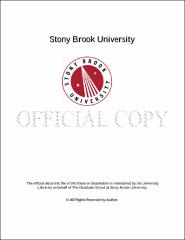| dc.identifier.uri | http://hdl.handle.net/11401/76930 | |
| dc.description.sponsorship | This work is sponsored by the Stony Brook University Graduate School in compliance with the requirements for completion of degree. | en_US |
| dc.format | Monograph | |
| dc.format.medium | Electronic Resource | en_US |
| dc.language.iso | en_US | |
| dc.publisher | The Graduate School, Stony Brook University: Stony Brook, NY. | |
| dc.type | Thesis | |
| dcterms.abstract | Caveolae are nanoscale invaginations found in the plasma membrane of mammalian cells, and are implicated in numerous essential cellular communication and transport processes. They are characterized by a coat composed of caveolin and cavin proteins. Recent studies of the caveolar coat complex suggest that cavin-1 associates with caveolin-1 during caveolae biogenesis. However, it is not known how this binding occurs. Studies of the spatial and physical interactions between cavin-1 and caveolin-1 can provide valuable insights into the mechanism of caveolae generation. The goal of this study was to test two different fusion tags to purify a sufficient quantity of cavin-1, for use in future binding studies with caveolin-1. We successfully generated a plasmid encoding 6His-SUMO-cavin-1 by cloning full length cavin-1 into the LIC SUMO vector 2S-T, and expressed it in BL21 (DE3) pLysS. Parameters of temperature, concentration of IPTG, detergent type, and length of incubation after IPTG-induction, were tested to optimize cavin-1 expression conditions. Immobilized metal affinity chromatography with Ni-NTA resin tested binding and release of the SUMO-tagged cavin-1. The poor protein yields from tests on 6-His-SUMO-cavin-1 underscored persistent issues of solubility, suboptimal binding to the resin, and inadequate release of purified protein. Studies on an earlier construct, GST-cavin-1, were then resumed to evaluate and maximize binding and release of GST-cavin-1 from glutathione-agarose beads. While inefficient bead binding problems remained, GST-cavin-1 yielded a more consistent recovery of the desired protein. As results suggested that enough soluble GST-cavin-1 could be obtained for binding studies, we performed a large-scale preparation of the protein for use in a diagnostic test for association with caveolin-1. We did not observe any binding in this preliminary test. The results prompted further questions about the stoichiometry of the cavin-1 and caveolin-1 complex, and highlighted the possibility of additional layers of complexity involved in this interaction. | |
| dcterms.available | 2017-09-20T16:51:27Z | |
| dcterms.contributor | French, Jarrod. | en_US |
| dcterms.contributor | Brown, Deborah | en_US |
| dcterms.creator | Siddiqui, Safa Farjand | |
| dcterms.dateAccepted | 2017-09-20T16:51:27Z | |
| dcterms.dateSubmitted | 2017-09-20T16:51:27Z | |
| dcterms.description | Department of Biochemistry and Cell Biology. | en_US |
| dcterms.extent | 77 pg. | en_US |
| dcterms.format | Monograph | |
| dcterms.format | Application/PDF | en_US |
| dcterms.identifier | http://hdl.handle.net/11401/76930 | |
| dcterms.issued | 2015-12-01 | |
| dcterms.language | en_US | |
| dcterms.provenance | Made available in DSpace on 2017-09-20T16:51:27Z (GMT). No. of bitstreams: 1
Siddiqui_grad.sunysb_0771M_12533.pdf: 2034619 bytes, checksum: 5b594d51ced2ef7e6d220ee04b580047 (MD5)
Previous issue date: 1 | en |
| dcterms.publisher | The Graduate School, Stony Brook University: Stony Brook, NY. | |
| dcterms.subject | Biochemistry | |
| dcterms.subject | caveolae, cavin-1, protein purification | |
| dcterms.title | Developing Tools for Cavin-1 Purification and Binding Studies with Caveolin-1 | |
| dcterms.type | Thesis | |

